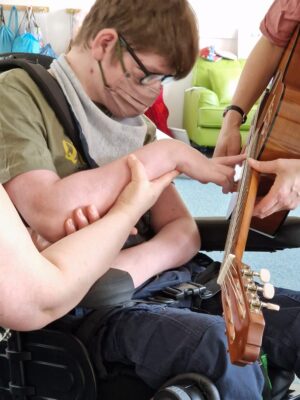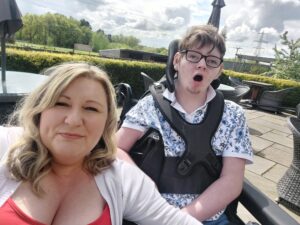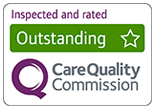
Vanessa’s son Jamie loves music therapy. Here she, and our music therapist Wendy, explain the difference it makes.
“Music therapy for Jamie, especially when he’s not well, is amazing. It can help him feel better, make him feel safe and calm, create a memory for us or just make him happy,” explains Vanessa.
Vanessa’s son Jamie is 14 and has a rare genetic syndrome that means he is unable to walk, talk or feed himself. He relies on lots of medical technology to keep him well, such as a ventilator, and his mum provides around the clock care. The Claire House team have been supporting him at home, online or whilst he has been in hospital for two years.
“Jamie is a wonderful young man who likes what he likes, and he loves music. He’s non-verbal but really affectionate. He gives you a wink if he likes you, and if you’re really special hedouble winks.
“He likes listening to songs, playing instruments and singing. We listen to all kinds of music, from dance to Pavarotti and opera,” says Vanessa.
As well as getting support to manage his condition, Jamie has been doing music sessions with the hospice music therapist, Wendy.
Wendy uses music and sound to address children’s physical and psychological wellbeing. Nobody is ruled out, even a child with profound hearing loss can respond to feeling vibrations.
Wendy explains: “My work is really important for the children and families who are going through huge challenges – music therapy gives them a way of expressing themselves.
“I work with a range of ages and abilities, from newborn babies to young adults. With one child I might use music to help their speech development or some area of movement, with another it might be helping to express how they are feeling.”
 Vanessa says: “I’m so grateful that Jamie gets to do these sessions, because he and other children really need them. Wendy is amazing. You can be sitting in a hospital room feeling really miserable, then the music starts and it’s uplifting. It can change a child; it can change the whole atmosphere.
Vanessa says: “I’m so grateful that Jamie gets to do these sessions, because he and other children really need them. Wendy is amazing. You can be sitting in a hospital room feeling really miserable, then the music starts and it’s uplifting. It can change a child; it can change the whole atmosphere.
“Wendy pulls out all the stops in our sessions. She does turn-taking with Jamie, she copies him or we sing and Jamie loves listening. She has a range of instruments and lets him pick which one he wants.
“One time Jamie had an electric guitar, I had a ukelele and Wendy a guitar. We sang The Greatest Showman. It was absolutely like we were in the film. He might as well have had a tuxedo and a top hat.”
“Most children like music, so if you’re trying to get them to do something, or stop doing something, music can help with that It engages naturally,” explains Wendy.
“I’m a classically trained violinist, I play piano and I’ve taught myself guitar. At the hospice I use lots of percussion instruments, bell shakers and castanets, big drums, melodic hand bells, harps, and a piano. We also use technology, such as iPads with music-based apps.
“When I work with a child who is non-verbal, like Jamie, they might know lots of songs even though they can’t speak. They hear something and can start making noise with an instrument, or it might be that songs aren’t that meaningful but I can find sounds that amuse them.
“In other sessions, I encourage mums to sing to their babies. There is lots of evidence that this forms bonds, helps with development, communication and movement.
“Young people may not want to use words to talk about things that are painful or frightening, and music can be a way around that. I work with young people who want to create their own music or share songs that are important to them. They let you into their world by listening to music with you.
“I’ve done sessions with families when their child is coming to the end of their life. This might be one of the last positive memories they are left with. I’ve even worked with families once their child has passed away and played to them whilst they have been resting in our Butterfly Suite.
“There is a magic about music. It’s a way of having a shared experience. It’s good for your mood and health. Thanks to everyone who helps make these sessions happen.”

